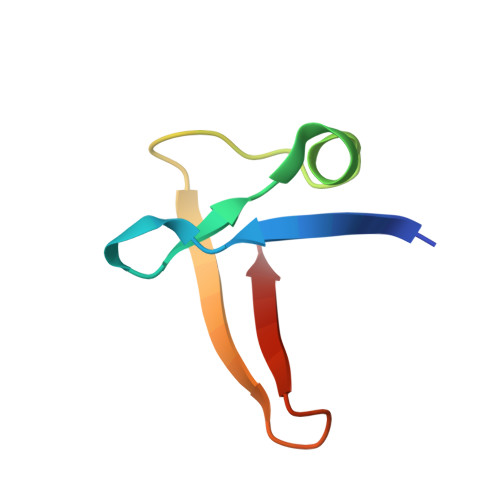The Arginine Pairs and C-Termini of the Sso7c4 from Sulfolobus solfataricus Participate in Binding and Bending DNA.
Lin, B.L., Chen, C.Y., Huang, C.H., Ko, T.P., Chiang, C.H., Lin, K.F., Chang, Y.C., Lin, P.Y., Tsai, H.H.G., Wang, A.H.J.(2017) PLoS One 12: e0169627-e0169627
- PubMed: 28068385
- DOI: https://doi.org/10.1371/journal.pone.0169627
- Primary Citation of Related Structures:
5ITJ, 5ITM - PubMed Abstract:
The Sso7c4 from Sulfolobus solfataricus forms a dimer, which is believed to function as a chromosomal protein involved in genomic DNA compaction and gene regulation. Here, we present the crystal structure of wild-type Sso7c4 at a high resolution of 1.63 Å, showing that the two basic C-termini are disordered. Based on the fluorescence polarization (FP) binding assay, two arginine pairs, R11/R22' and R11'/R22, on the top surface participate in binding DNA. As shown in electron microscopy (EM) images, wild-type Sso7c4 compacts DNA through bridging and bending interactions, whereas the binding of C-terminally truncated proteins rigidifies and opens DNA molecules, and no compaction of the DNA occurs. Moreover, the FP, EM and fluorescence resonance energy transfer (FRET) data indicated that the two basic and flexible C-terminal arms of the Sso7c4 dimer play a crucial role in binding and bending DNA. Sso7c4 has been classified as a repressor-like protein because of its similarity to Escherichia coli Ecrep 6.8 and Ecrep 7.3 as well as Agrobacterium tumefaciens ACCR in amino acid sequence. Based on these data, we proposed a model of the Sso7c4-DNA complex using a curved DNA molecule in the catabolite activator protein-DNA complex. The DNA end-to-end distance measured with FRET upon wild-type Sso7c4 binding is almost equal to the distance measured in the model, which supports the fidelity of the proposed model. The FRET data also confirm the EM observation showing that the binding of wild-type Sso7c4 reduces the DNA length while the C-terminal truncation does not. A functional role for Sso7c4 in the organization of chromosomal DNA and/or the regulation of gene expression through bridging and bending interactions is suggested.
Organizational Affiliation:
Institute of Biological Chemistry, Academia Sinica, Taipei, Taiwan.














